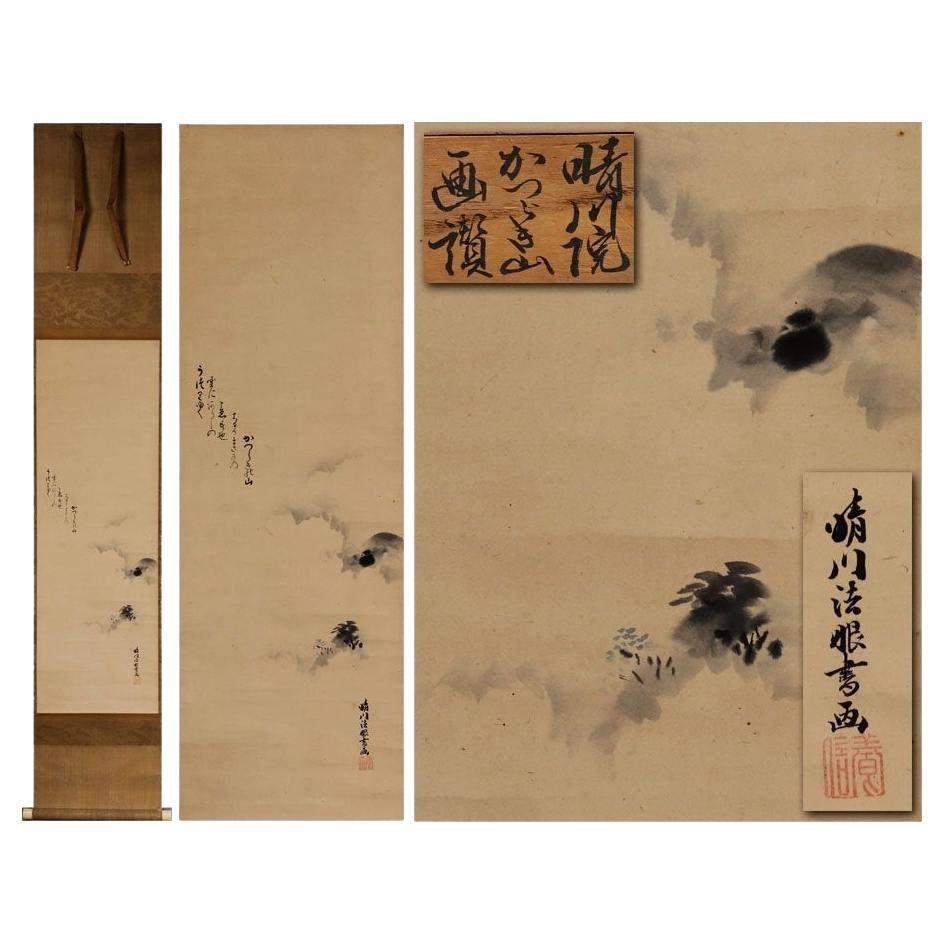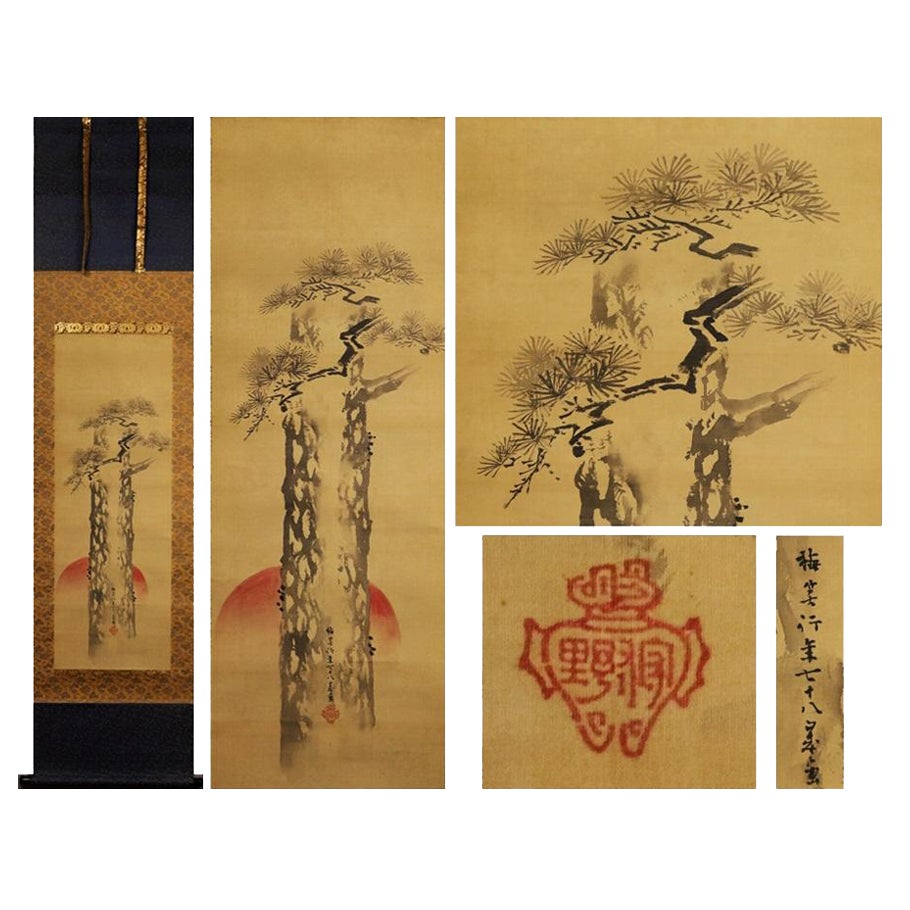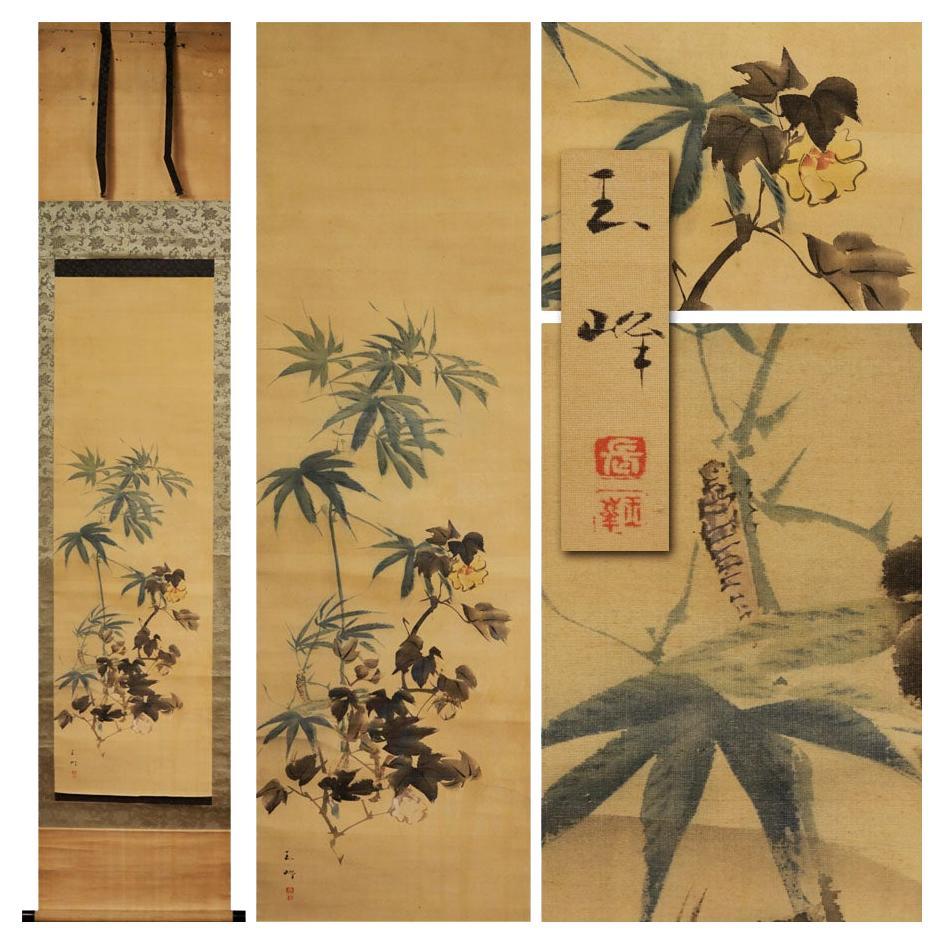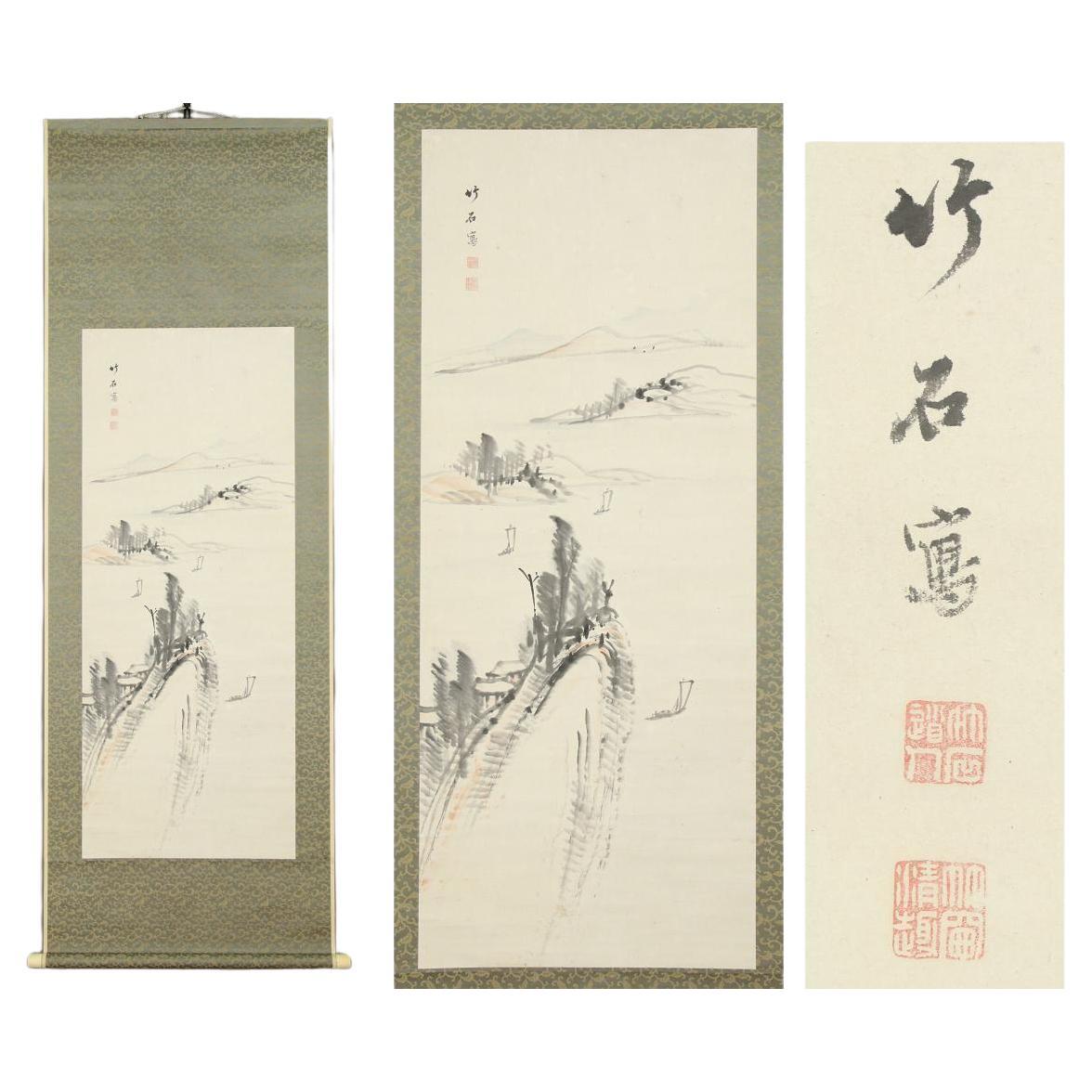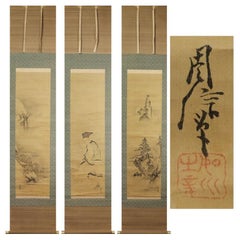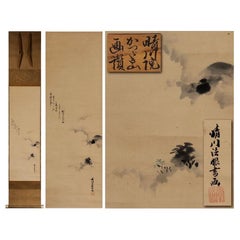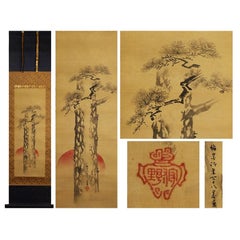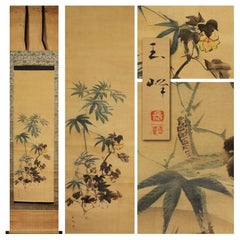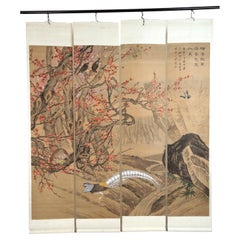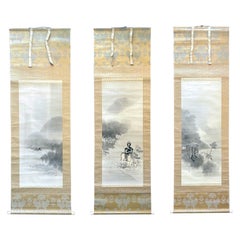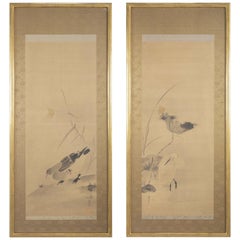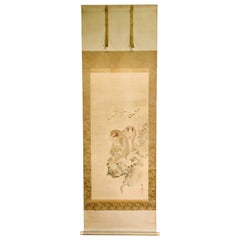Items Similar to Lovely Japanese 18/19th c Edo Scroll Triptyque , Fuji, Dragon Flowers
Want more images or videos?
Request additional images or videos from the seller
1 of 8
Lovely Japanese 18/19th c Edo Scroll Triptyque , Fuji, Dragon Flowers
$1,715.88
$2,144.8520% Off
£1,268.58
£1,585.7220% Off
€1,438.40
€1,79820% Off
CA$2,360.17
CA$2,950.2220% Off
A$2,623.48
A$3,279.3520% Off
CHF 1,375.17
CHF 1,718.9620% Off
MX$32,039.01
MX$40,048.7720% Off
NOK 17,168.22
NOK 21,460.2720% Off
SEK 16,152.09
SEK 20,190.1120% Off
DKK 10,950.52
DKK 13,688.1420% Off
About the Item
This is a pair of Edo period pieces, each with a beautiful ``cherry blossoms and swallow'', ``Fuji and rising dragon'', and ``wild geese'' .
■Silk book, handpainted
■Condition:
There are some discolorations and stains due to the age.
There are small insect damage marks on the ``Wild Geese'' scroll.
■Dimensions
Axis dimensions: approx. 153.5cm x approx. 40.5cm.
Paper dimensions: approx. 84.0cm x approx. 31.5cm. ■ There are inscriptions, seals, etc. as shown in
the seal .
■Box box.
- Dimensions:Height: 60.44 in (153.5 cm)Width: 15.95 in (40.5 cm)Depth: 0.04 in (1 mm)
- Style:Edo (Of the Period)
- Materials and Techniques:
- Period:
- Date of Manufacture:1800
- Condition:Wear consistent with age and use.
- Seller Location:Amsterdam, NL
- Reference Number:Seller: 2401stDibs: LU4863236903762
About the Seller
5.0
Gold Seller
Premium sellers maintaining a 4.3+ rating and 24-hour response times
Established in 2015
1stDibs seller since 2019
266 sales on 1stDibs
Typical response time: 6 hours
- ShippingRetrieving quote...Shipping from: Amsterdam, Netherlands
- Return Policy
Authenticity Guarantee
In the unlikely event there’s an issue with an item’s authenticity, contact us within 1 year for a full refund. DetailsMoney-Back Guarantee
If your item is not as described, is damaged in transit, or does not arrive, contact us within 7 days for a full refund. Details24-Hour Cancellation
You have a 24-hour grace period in which to reconsider your purchase, with no questions asked.Vetted Professional Sellers
Our world-class sellers must adhere to strict standards for service and quality, maintaining the integrity of our listings.Price-Match Guarantee
If you find that a seller listed the same item for a lower price elsewhere, we’ll match it.Trusted Global Delivery
Our best-in-class carrier network provides specialized shipping options worldwide, including custom delivery.More From This Seller
View AllJapanese Painting 17th c Edo Scroll Triptyque Kano Chikanobu Buddhist Painting
Located in Amsterdam, Noord Holland
TheItem below was painted approximately 300 years ago by Kano Chikanobu. In the center is a depiction of a deer hermit, on the right is a landscape of a tower that gives a sense of ...
Category
Antique 17th Century Edo Paintings
Materials
Silk
$3,433 Sale Price
20% Off
Lovely Japanese 18/19th c Edo Scroll Kano Osanobu Nihonga Painting Mountain
Located in Amsterdam, Noord Holland
Kano Osanobu (狩野養信)
Osanobu Kano (born August 18, 1796; died June 12, 1846) was the ninth painter of the Kobikicho Kano School in the Edo period. His common name was Shozaburo. His father was Naganobu KANO, and Tadanobu KANO was his son. His Go (pen name) was Osanobu Seisenin, Kaishinsai, and Gyokusen.
Brief Personal History
He was born the eldest son of Naganobu ISENIN during the Edo period. He was first sent to serve at Edo Castle at the age of 15, and it appears that he was apparently pushed by his father to perform various public tasks for the Kanon School. He kept a diary for 36 years, starting from the day before he first went into service at Edo Castle until the day before he died. The diary is entitles "Official Service Diary" (it consists of 52 volumes that are maintained at the Tokyo National Museum, and 4 volumes that are separately maintained at the different families), and have become the focus of a lot of attention in recent years for the detailed information they present on the daily life and work of a prestigious official painter. The reading of the characters of his name was originally "Takenobu"; however, with the birth of the first son of the Shongun Ieyoshi TOKUGAWA in 1813, whose name was Takechiyo, having a sylable with the same pronunciation of "Take"was deemed to be inappropriate, and was therefore changed to "Osanobu". Because Takenobu died the following year, after which he was referred to as Gyokujuin, Osanobu changed his pen name Gyokusen he had used until that point to Seisenin, in order to avoid using the same Chinese charcter pronounced alike. In 1819, he attained the second highest rank for a Buddhist priest, Hogen, and assumed the role of head of the family after his father passed away in 1828. In 1834 he attained the highest rank for a Buddhist priest, Hoin. He oversaw the rennovation of the wall paintings of Nishinomaru Palace of Edo Castle from 1838 to 1839, and Honmaru Palace of it from 1844 to 1846. It is thought that Osanobu later died due to the fatigue...
Category
Antique 18th Century Edo Paintings
Materials
Silk
$1,715 Sale Price
20% Off
Antique Japanese 18th c Edo Scroll [Kano Baisho Nihonga Landscape Painting
Located in Amsterdam, Noord Holland
This is a ``Rising Sun and Pine Tree'' drawn by Kano Baisho.
It is an item with a solemn taste and presence, and I think it would be a good idea to display it at New Year's, the fir...
Category
Antique 18th Century Edo Paintings
Materials
Silk
$3,433 Sale Price
20% Off
Lovely Japanese 18th c Edo Scroll by Tamamine Hasegawa , Flowers 19th c
Located in Amsterdam, Noord Holland
The following is a beautiful work of Fuyo drawn by Hasegawa using a skillful brush.
[Hasegawa]
1822-1879 Painter from the late Edo period to the Meiji period.
*Painter born...
Category
Antique 19th Century Edo Paintings
Materials
Silk
$1,715 Sale Price
20% Off
Lovely Japanese 19th c Edo Scroll Okumura Sekiran Nihonga Painting Mountain
Located in Amsterdam, Noord Holland
"Early Summer Colored Waterfall" is a work drawn by Sekiran Okumura as you can see.
The brilliance of the fresh greenery and the cool, powerful presence of the waterfall are overw...
Category
Antique 18th Century Edo Paintings
Materials
Silk
$1,715 Sale Price
20% Off
Japanese Painting 18c Edo Scroll Chikuseki Nagamachi Nihonga Landscape Painting
Located in Amsterdam, Noord Holland
[Authentic Artwork] ◆ Nagamachi Chikuseki ◆ Landscape ◆ Edo Period ◆ Mitsuishi Origin ◆ Kagawa Prefecture ◆ Handwritten ◆ Paperback ◆ Hanging Scroll ◆ k891 ◆ Nagamachi Chikuseki
Explore the artistry of Chikuseki Nagamachi...
Category
Antique 18th Century Edo Paintings
Materials
Silk
$1,811 Sale Price
20% Off
You May Also Like
Set of Four Japanese Silk Hanging Scrolls Screens C.1920
Located in London, GB
A stunning set of four Japanese silk mounted vertical hanging scrolls.
Dating from C.1920 Taisho Period.
The watercolour and ink on silk depicts a larg...
Category
Vintage 1920s Japanese Japonisme Paintings and Screens
Materials
Silk
$6,015 Sale Price / set
20% Off
Rare Triptych Scroll Paintings by Watanabe Seitei Meiji Period
Located in Atlanta, GA
A set of three paintings of ink and watercolor on silk mounted within brocade borders as scrolls by Watanabe Seitei (1851-1918). This is a very rare an...
Category
Antique Early 1900s Japanese Japonisme Paintings and Screens
Materials
Brocade, Silk, Wood
Pair of Japanese Framed Scrolls with Lotus, White Heron and Duck Decoration
Located in Stamford, CT
Pair of 19th century Japanese scrolls in frames with lotus, white heron circle of Kano Naonobu (Japan, 1607-1660) and duck beside a pond.
Category
Antique Mid-19th Century Japanese Paintings and Screens
Materials
Paper
Japanese Silk Scroll Painting of Moneys Edo Period Mori Tetsuzan
Located in Atlanta, GA
A Japanese mounted vertical hanging scroll painting by Mori Tetsuzan (Japanese, 1775-1841) circa 19th century Edo period. The watercolor and ink on silk ...
Category
Antique 19th Century Japanese Japonisme Paintings and Screens
Materials
Silk, Paper
Japanese ink on paper painting of Plum Blossoms, Tani Buncho
Located in Point Richmond, CA
Japanese ink on paper painting of Plum Blossoms and Poem, scroll mounting, signature & single seal: Tani Buncho (1763 - 1840). A famous and prol...
Category
Antique 19th Century Japanese Meiji Paintings and Screens
Materials
Paper
Japanese Screen Painting, Circa 1700 'Tales of Ise' by Tosa Mitsusuke
By Tosa Mitsusuke 1
Located in Kyoto, JP
A six-fold Japanese screen by Tosa Mitsusuke (1675-1710), Japan 17th-18th century, Edo period.
The signature reads Shoroku-i ge Tosa sa Konoe Shogen Mit...
Category
Antique Late 17th Century Japanese Edo Paintings and Screens
Materials
Gold Leaf
More Ways To Browse
Japanese Scroll Flower
Japanese Dragon Painting
18th Century Japanese Silk Painting
Antique Bird Nest Prints
Antique Egyptian Doors
Antique Freight Elevator
Antique Horse Ornament
Antique Rose Quartz
Antique Victorian Buttons
Bombay Chests
Bronze Thai Hand
Ceramic Hen
Champleve French Clocks
Chinese Bronze Buddha
Chinese Lacquer Wall Panels
Chinese Tapered Cabinet
Chinoiserie Wood Panel Art
Circular Art Deco Cabinet

